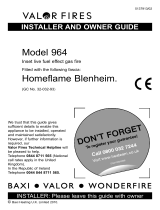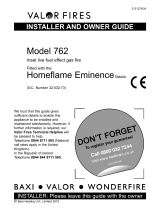
200mm diameter factory made insulated flue manufactured to BS4543.
175mm diameter flue pipe. See BS6461 Part 1 for suitable materials.
The minimum effective height of the flue must be 3m.
The flue must not be used for any other appliance or application.
Any chimney damper or restrictor should be removed. If removal is not possible, they
must be secured in the open position.
If the appliance is intended to be installed to a chimney that was previously used for
solid fuel, the flue must be swept clean prior to installation.
All flues should be inspected for soundness and freedom from blockages.
4.3 If the fireplace opening is an underfloor draught type, it must be sealed to stop
any draughts.
4.4 The appliance must be mounted behind a non-combustible hearth (N.B.
conglomerate marble hearths are considered as non-combustible). The appliance can be
fitted to a minimum class “O” – 100°C surround. The hearth material must be at least
12mm thick. The periphery of the hearth (or fender) should be at least 50mm above
floor level to discourage the placing of carpets or rugs over it (See figure 1).
The surface of the hearth must be sufficiently flat to enable the bottom of the front
surround and the bottom front cover to be aligned horizontally. Any excessive
unevenness (uneven tiles, Cotswold stone, etc.) should be rectified.
4.4.1. 'Hole-in-the-wall' Installations
For installation without the 'Liberty' casting
! It is recommended that a hearth should be installed as in figure 1.
For installation with the 'Liberty' casting
! It is recommended that a hearth should be installed as in figure 2.
For installation with and without the 'Liberty' casting
! If a reduced depth Hearth is fitted, the fire must be installed so that the distance
from the base of the fireplace opening in the wall to the finished floor level is 75mm
minimum. It is recommended that the reduced hearth has a depth from the fixing plane
of the fire of 100mm minimum. This is necessary to support the lower front casting. The
minimum shelf height will have to be taken from the base of the fireplace opening.
4.5 If the Fireplace opening is greater than the acceptable dimensions given in this
guide, do not use the back of a fire surround or marble to reduce the opening. This may
cause cracking of the surround back or marble
4.6 The appliance must not stand on combustible materials or carpets.
Page 8
INSTALLER GUIDE






















